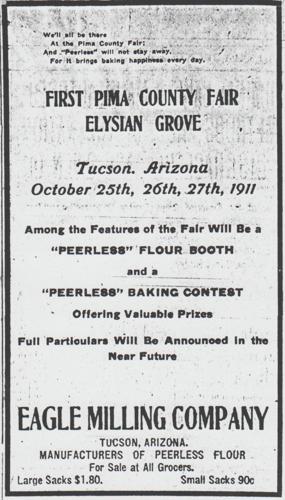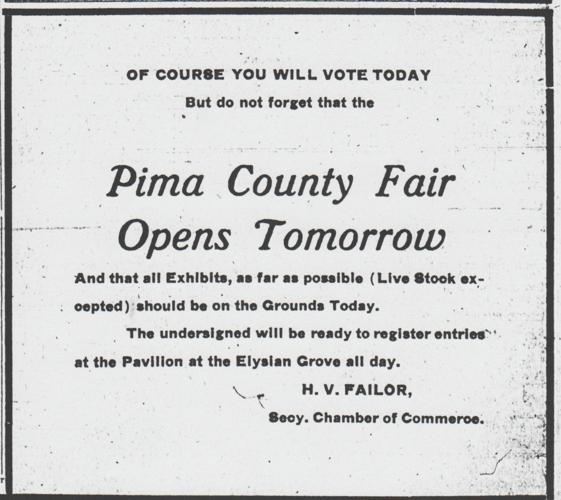Note to readers: This is a reprint of a 2015 article.
Burro races, 25-cents admission, schools closed, 50 cakes vying for prizes, Holsteins and Jerseys getting judged, an orchestra playing, potions for sale.
Pima County's very first fair, in 1911, was a big deal in the Old Pueblo.
On Oct. 6, 1911, the Arizona Daily Star wrote, “During the latter part of this month there will be given in this city a Pima County fair. … A county fair is an innovation in this immediate vicinity, but it is another of those innovations which denote progress … The exhibition of agricultural products, the livestock, the minerals, and other resources of a county proves an inspiration even to the oldest inhabitant … It will be the nucleus of larger and better fairs year after year.”
On Oct. 10 of that year, Frank Colt, a farmer on the Rillito River, promised to exhibit watermelons, beans, pumpkins and Irish potatoes at the fair.
The following day, the Pima County Fair Commission visited the future fair site, the Elysian Grove amusement park downtown, about where Carrillo Magnet Elementary School (440 S. Main Ave.) is now. The plan was to have a pavilion with three rows of booths, with one row down the center of the building and one on each side.
Also on Oct. 11, the sports committee of the Pima County Fair Association announced a lineup that included a football game between Tucson High School and Phoenix High School, burro races for boys and girls and a bronco-busting contest.
General admission to the fair was to cost 25 cents for adults, with extra fees for the football game.
As the fair date drew closer, the Tucson Chamber of Commerce began taking out ads in the newspaper, asking for merchants to donate items and also money for prizes. It also requested more exhibitors to show their prized animals, merchandise and other items of interest.
Educational institutions such as the University of Arizona, the Methodist School for Mexican Girls and the Presbyterian Indian Industrial School also advertised that they would be exhibiting their work on the first day of the fair.

Ad for the Pima County Fair on Oct. 24, 1911, in the Arizona Daily Star.
Opening day would be known as Children’s Day, and schools would be closed.
By Oct. 20, all of the booths in the pavilion had been taken by Tucson merchants, including the Eagle Milling Co., Russell Electric & Machine Co. and W.F. Kitt’s & Sons.
Oct. 25, the first day of the fair, saw a large crowd at Elysian Grove. Highlights of the day included the Tucson High-Phoenix High football game. The local team outclassed the visiting team 38-0, but the game kept a good nature to it and there were no injuries to report.
T. Ed Litt’s drug store display seemed to garner much attention in the newspaper. The Star reported: “Mr. Litts has something for everyone who has come along and all his gifts are of the useful kind … Of his gifts, he has for the ladies a sample of Creme Innovation; to the men who come to him he is apt to offer an announcement of the Witter Springs Water … Besides these there are the well-known Foley’s Honey and Tar remedy for colds … Nydenta Creme for the teeth …and the world-famous Janus vacuum bottles.”
The mineral section for the first fair was small, with only four collections from the Tucson Chamber of Commerce, the University of Arizona, Ivanhoe Mines and a private collection. But a photographic display of large panoramas of mines in the Arizona Territory appears to have made up for it.
The second day of the fair featured a poultry show, stock show and dog show. The stock show included judging by Prof. W.L. Fowler of many different types of cattle, such as Holsteins, Jerseys and Ayrshires, many of them owned by the university and, therefore, not eligible for prizes. Both the Flowing Wells Dairy and Autrey & Peterson took home prizes for their fine cattle.
The day also saw multiple horsemanship contests, including a Gentleman’s Riding Contest and a Ladies Driving Contest. But rain began pouring down around 3:30 p.m. and prevented many of the horse exhibits and field sports from being presented.

Ad for the Pima County Fair on Oct. 18, 1911, in the Arizona Daily Star.
On the third day, the bronco-busting show likely was the most rousing affair, but the Peerless (Flour) Baking Contest at the Eagle Milling Co. booth was a huge hit. It included about 50 cakes, rolls, biscuits and bread. After judging was completed, the items were sent to the St. Joseph’s Orphanage.
The fourth and final day of the fair was a make-up day for the events that didn’t happen due to the earlier rain. That included a pony race for kids under age 15 and a tallyho coach exhibition. The pavilion was open into the evening with an orchestra playing for the crowd.
On Oct. 30, 1911, Secretary H.V. Failor of the Tucson Chamber of Commerce or his assistant handed out the blue and red ribbons to winners.
The fair has been held at several locations over the years. In 1932, it moved to the old airport site, which was renamed the Fair Grounds (now the Rodeo Grounds).
Fair Avenue was built that same year as an alternative route to and from the grounds, but it’s believed the project was only partially completed. And that's why Fair Avenue is nowhere near today's fairgrounds at 11300 S. Houghton Road, where the 2024 fair is underway through April 28.
Noxious stinknet weeds caught trying to sneak into the Pima County Fair





